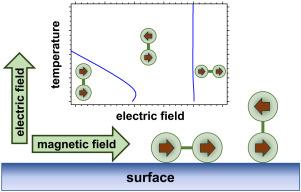Hubbard dimer in near-surface magnetic and electric field: Magneto-electro-spatial phase transitions
IF 3
3区 材料科学
Q3 MATERIALS SCIENCE, MULTIDISCIPLINARY
引用次数: 0
Abstract
In the paper we present a computational study of a model involving Hubbard dimer located at the surface, with parallel or perpendicular orientation possible. The dimer is immersed in electric field and inhomogeneous magnetic field, moreover, the charge transfer between the dimer and the surface is controlled by the chemical potential. The thermodynamic description is based on exact diagonalization within grand canonical ensemble formalism and focused on determination of dimer orientation, magnetization and electric polarization. The phase diagrams for ground state and finite temperatures are constructed and discussed. The possibility of cross-overs between the parallel and the perpendicular dimer orientation under the influence of the electric or magnetic field is demonstrated. The cross-overs are accompanied by the changes in such thermodynamic quantities as magnetization and electric polarization. The calculations enable the extensive discussion of the magneto-electro-spatial phase transitions in the system.

近地表磁场和电场中的哈伯德二聚体:磁电空间相变
在本文中,我们提出了一个模型的计算研究涉及哈伯德二聚体位于表面,平行或垂直方向可能。二聚体浸泡在电场和非均匀磁场中,二聚体与表面之间的电荷转移受化学势控制。热力学描述基于大正则系综形式下的精确对角化,着重于二聚体取向、磁化和电极化的确定。构造并讨论了基态和有限温度下的相图。证明了在电场或磁场的作用下,平行二聚体取向和垂直二聚体取向之间存在交叉的可能性。交叉过程伴随着诸如磁化和电极化等热力学量的变化。通过计算,可以广泛地讨论系统中的磁-电-空间相变。
本文章由计算机程序翻译,如有差异,请以英文原文为准。
求助全文
约1分钟内获得全文
求助全文
来源期刊

Journal of Magnetism and Magnetic Materials
物理-材料科学:综合
CiteScore
5.30
自引率
11.10%
发文量
1149
审稿时长
59 days
期刊介绍:
The Journal of Magnetism and Magnetic Materials provides an important forum for the disclosure and discussion of original contributions covering the whole spectrum of topics, from basic magnetism to the technology and applications of magnetic materials. The journal encourages greater interaction between the basic and applied sub-disciplines of magnetism with comprehensive review articles, in addition to full-length contributions. In addition, other categories of contributions are welcome, including Critical Focused issues, Current Perspectives and Outreach to the General Public.
Main Categories:
Full-length articles:
Technically original research documents that report results of value to the communities that comprise the journal audience. The link between chemical, structural and microstructural properties on the one hand and magnetic properties on the other hand are encouraged.
In addition to general topics covering all areas of magnetism and magnetic materials, the full-length articles also include three sub-sections, focusing on Nanomagnetism, Spintronics and Applications.
The sub-section on Nanomagnetism contains articles on magnetic nanoparticles, nanowires, thin films, 2D materials and other nanoscale magnetic materials and their applications.
The sub-section on Spintronics contains articles on magnetoresistance, magnetoimpedance, magneto-optical phenomena, Micro-Electro-Mechanical Systems (MEMS), and other topics related to spin current control and magneto-transport phenomena. The sub-section on Applications display papers that focus on applications of magnetic materials. The applications need to show a connection to magnetism.
Review articles:
Review articles organize, clarify, and summarize existing major works in the areas covered by the Journal and provide comprehensive citations to the full spectrum of relevant literature.
 求助内容:
求助内容: 应助结果提醒方式:
应助结果提醒方式:


